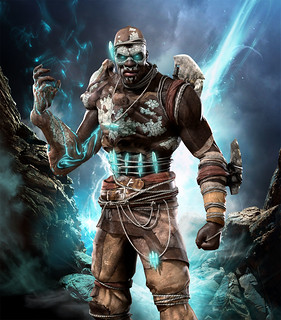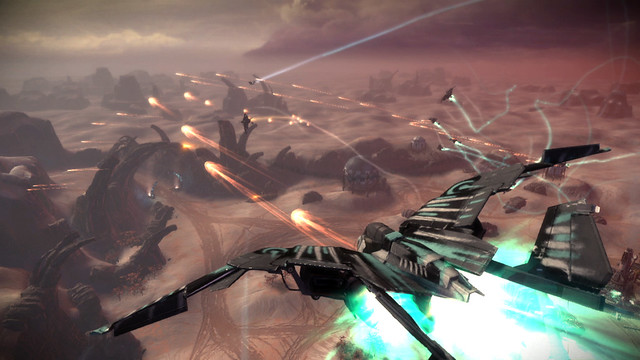Though legions of bloodthirsty PSN warriors have plunged into Starhawk’s multiplayer beta, the single-player campaign has remained stubbornly cloaked in shadow. Until now: At a media event in New York City this week, Lightbox Interactive finally gave a peek under that cloak, showcasing a series of frantic battles and lush cinematic sequences from the game’s story-driven campaign. As Emmett Graves, an interstellar mercenary infected by a priceless but mutagenic resource dubbed “Rift energy,” you’ll use the game’s dramatic Build and Battle combat system to call down turrets, walls, vehicles and structures from outer space. Your objective is to defend the frontier town of White Sands from marauding Outcast invaders — including your Rift-possessed outlaw brother Logan.


Starhawk’s Western-tinged story is told through lavishly illustrated cut-scenes that weave in and out of the gameplay, seamlessly connecting the action sequences and, better still, cutting between-mission load times to the bone. I sampled several minutes of the campaign and was pleased to discover a fast-paced yet strategic sandbox shooter that grants the player an unusually wide array of options. In one mission, Emmett’s partner Cutter directed me to commandeer a nearby tank in order to flush out several nearby mortar emplacements that threatened the town of White Sand. I demurred, preferring to remain on-foot and rely on my trusty laser-guided rocket launcher to peg the enemy vehicles from a distance. It was a somewhat foolish decision but I appreciated having a choice.
I wish I could detail everything I saw (hint: I saw an awful lot), but Lightbox Interactive is understandably sensitive about spoilers. Suffice it to say that the game’s campaign appears to be a meaty experience, serving up far more than a weak-kneed warm-up for the obligatory multiplayer modes. I spoke with Lightbox Interactive President Dylan Jobe to try and pry out details in advance of the game’s May 8th launch. And this is just the beginning — Jobe has even more to say in his interview on the latest PlayStation Blogcast. Read on and leave your questions in the comments!
PlayStation.Blog: Lightbox Interactive has been fairly secretive about Starhawk’s single-player campaign. What sparks Emmett Graves’ quest?
Dylan Jobe, President, Lightbox Interactive: It doesn’t start out as a quest for Emmett — it starts off as a job. Emmett is a Rift energy salvager, and he’s good at what he does. He and his partner Cutter go into the frontier, find claims that are under attack by the Outcast, and defend them.
But it just so happens that Emmett’s latest job is back on Dust, in his hometown of White Sands. And because Emmett and his brother Logan went separate ways many years ago – Logan to the Outcast, Emmett staying with humanity — Emmett takes the job in order to bring his outlaw brother to justice. The whole single-player game is about Emmett confronting his brother and protecting his hometown.
PSB: Starhawk’s Western themes seem to extend beyond the art direction – they’re much deeper than I expected.
DJ: The Western theme influenced not only the things you’d expect, like the visuals. It influenced the music composition, the structure of the narrative, the open vastness of the frontier, the expansion and building, the Gold Rush…even the intimate story between Emmett and his brother Logan. The Western themes seeped into all aspects of the game.
PSB: Starhawk’s campaign battles give the player an unusual amount of freedom. Have shooters become too cut-and-dried?
DJ: First and foremost, we want this game to be unique. The shooter genre is packed with mega-juggernaut great games, but shooters are also due for a twist. In most single-player shooters, you play a linear experience: event, event, event, set piece, event, event, event, set piece. With Starhawk, we wanted to give the player a combat challenge: Here’s what’s going to attack you, here’s when it’s going to attack you, and here are the tools you can use. Now play it however you want!
This approach is easier said than done because it introduces a lot of bugs during the design process, but it’s exciting because different players will stumble across many different strategies for success. You might love flying the Hawks and want to use them as many scenarios as possible, and that’s perfectly fine.

PSB: The co-op mode seems to push that sandbox philosophy as far as it will go. How does it work?
DJ: Co-op teams up you with up to three other players, and you’re defending a Rift claim. The system will randomize the encounters – say a wave of snipers or waves of different vehicles – and force you to adapt using the Build and Battle tools. Co-op is a fun way to play the game, but it also helps you learn how to defend your base in multiplayer, with the random encounters helping to simulate the randomness of humans you’ll fight online.
PSB: When I went hands-on with the campaign, I found myself battling enemies I never saw in the multiplayer mode – we’re talking radically different stuff here. I know you’re being tight-lipped, but what can you tell us?
DJ: In some respects, they’re similar to unit types you might find in an RTS game. You’ll encounter swarm-type characters, big brutes….they all have a different texture and impact the combat in different ways. I can’t go into a ton of detail, but I think you’ll be pleasantly surprised with the single-player, because you’ll find a ton of enemies and encounters you won’t find in multiplayer.
The campaign isn’t based on the multiplayer maps, either. This is a narrative-driven single-player experience, with unique maps and encounters all the way through the game. They range from small battles in the desert to huge space battles around capital ships to defending this huge space train to the epic confrontation with Logan — it’s quite diverse. A journalist I spoke with earlier watched me play two missions, and told me it was like two games worth of content. There are a lot of toys in this toolbox and you’re going to get your 60 bucks worth.
PSB: Rift energy is central to the game’s universe, it’s sort of like “blue gold.” But what is it, exactly?
DJ: There are hints about it, but we don’t want to pull a midichlorian [laughs]. You’ll learn more about the origins of Rift energy if you’re observant. But the important part is, Emmett is a ticking time bomb. He’s been infected by Rift energy and he’s wearing this regulator to buy time. His partner Cutter is trying to keep him from turning in an Outcast, but Emmett knows that some day he will turn. He’s effectively part human, part Outcast…and so he’s something of a dark hero, which is a classic component of Westerns.
